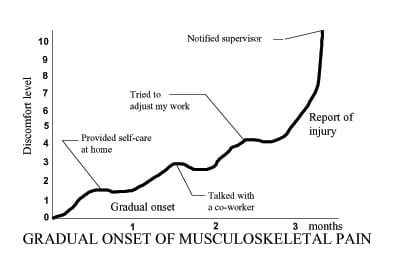Who gets involved in modifying duties - and how?

Q: How often does the employee modify their own duties?
A: The employee commonly modifies the way they do their duties in response to a problem.
The graph below from Dr Bill Shaw (Liberty Mutual) outlines an employee’s typical response to a muscular problem. Adjusting the way they do their job is an early and typical response.

Here are some examples of how employees modify the way they do their job:
- Talking to co-workers, who help out and do the parts of the job that are difficult for the employee with the problem
- Stopping to have a short stretching break
- Finding a stool to sit on or a trolley to lift something
- Rearranging where files or other instruments are stored to reduce reaching
When employees take control over their own modified duties the approach is often a simple and common sense one, and is easy to implement in all industries. Affording people flexibility to do this helps prevent 'medicalising' the condition.
Things to be aware of:
- Changes may be insufficient
- Employees mightn’t have a good understanding of other measures to be taken to more effectively modify duties
- Problems may go unattended and worsen
Q: How can the supervisor and manager involve themselves in their employees modified duties?
A: Supervisors and managers can get involved in numerous, and often very simple, ways.
For example:
- When a supervisor becomes aware of a person’s shoulder problem they can provide them with a trolley to avoid having to manually move items
- An office manager helps an employee with back pain by providing a wireless phone set so the employee can stand and move around the office while talking on the phone
When supervisors and managers are involved, a partnership develops with the employee, and they gain an understanding of the situation – which helps to give good advice to the employee as well as helping to prevent the problem from arising in the future. More significant changes may be possible when supervisor and manager are involved.
Things to be aware of:
- Supervisor may have a limited knowledge and understanding of ergonomics
- A supervisor with limited time and focus may be unsupportive and unhelpful
- A culture of “following suit” may develop among other employees if they are not helped to understand exactly why the particular modified duties have been arranged for one employee and not for them.
- Supervisors who are taught how to manage work injuries, and taught basic ergonomics, are more satisfied and do a better job of helping employees.
Q: How can a RTW Coordinator get involved?
A: A RTW coordinator who has basic ergonomic training/experience can make changes to the way a job is done, and teach the employee and supervisor about how to identify options. A return to work coordinator without ergonomics experience can involve a rehabilitation provider to assist.
Examples of what the RTW Coordinator can do include:
- Set up a discussion with a production manager and the machine operator with back pain to arrange the changing of the employees position for three months
- The Coordinator can become aware of an employee off work with neck pain, identify duties in the workplace that allow more flexibility in work tasks, and write up a return to work plan as the basis for discussion with the employee and the treating doctor
The benefits of having the RTW Coordinator lead the modified duties discussions include:
- A broader understanding of what can be achieved
- A big picture approach across the organisation
- A greater likelihood of follow up
- More chance of patterns of problems being recognised, leading to support for site improvements
In whichever way modified duties arrangements are reached in your workplace, the employee should always be involved in discussions.
Even when external decision makers are brought in to help with modified duties arrangements (an often less than ideal arrangement as it moves the decision making process away from the key people involved in return to work, ie the employee and the supervisor), the employee needs to be involved in order to have a sense of control over their own work and health.
Where the employee is not involved in determining modified duties, workplaces can also expect the employee to be less involved in rehabilitation. This means that there are likely to be poorer return to work results and higher expenses from injuries.

